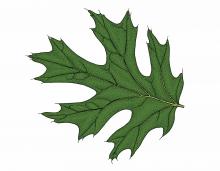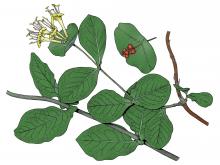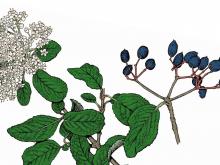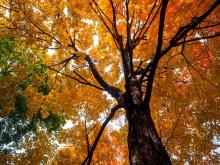Trees, Shrubs and Woody Vines
Media

Species Types
Scientific Name
Quercus velutina
Description
Black oak grows throughout Missouri, in upland woods, on glades, and along borders of woods and fields. It and scarlet oak were the primary colonizers of Ozark pinelands when the native pines were cleared in the early 1900s.
Media

Species Types
Scientific Name
Quercus shumardii
Description
Shumard oak is worth knowing: it can rise to 100 feet in height and gain a trunk diameter of 5 feet, with wide-spreading, muscular boughs.
Media

Species Types
Scientific Name
Lonicera dioica
Description
Limber honeysuckle is a native Missourian. It's uncommon and widely scattered in the state, but it does well as a trellis vine. Identify it by its crowded clusters of tubular, yellow or greenish-yellow flowers, tinged with red, purple, or pink, that are noticeably enlarged on one side at the base.
Media

Species Types
Scientific Name
Lonicera reticulata (formerly L. prolifera)
Description
One of Missouri's beautiful native honeysuckles, grape honeysuckle is found mainly in the northern two-thirds of the state. In the native plant garden, it is easy to grow, but it is not aggressive like the introduced invasive Japanese honeysuckle.
Media

Species Types
Scientific Name
Toxicodendron radicans
Description
Poison ivy is a toxic plant that contains an oil in all its parts that, if you come into contact with it, can cause an intense skin reaction. Learn to recognize it, and sidestep it on your outings.
Media

Species Types
Scientific Name
Parthenocissus vitacea (syn. P. inserta)
Description
Woodbine is a climbing woody vine that usually sprawls over bushes and rocks. Its leaves have five coarsely toothed leaflets. Unlike the closely related Virginia creeper, its tendrils generally lack sucker disks. It is rarely found in Missouri.
Media

Species Types
Scientific Name
Viburnum rufidulum
Description
Southern black haw is an irregularly branched shrub with shiny, dark green, opposite leaves whose lower surface is paler with scattered rusty hairs, especially on the veins. It bears clusters of white flowers, which turn into bluish-black fruits.
Media

Species Types
Scientific Name
Ulmus spp.
Description
Missouri has seven species of elms that grow in natural settings. Elms have tough, shock-resistant wood. In the past, some species were favorite shade trees, which is why so many towns have Elm Streets. But elms have suffered for a century from a devastating fungal disease.
Media

Species Types
Scientific Name
Fraxinus spp.
Description
Missouri has six species of ashes that you might find in natural settings. They have been very popular as shade trees, and their wood is famously useful. Ash trees of all the species in North America are currently being killed by the invasive, nonnative emerald ash borer.
Media

Species Types
Scientific Name
Acer spp.
Description
Missouri has five species of maples that are either native or naturalized, plus several that are known only in cultivation. Maples are important members of native ecosystems. They also provide stunning fall color, welcome shade in summer, commercially important lumber, and sap for syrup.
See Also
About Trees, Shrubs and Woody Vines in Missouri
There are no sharp dividing lines between trees, shrubs, and woody vines, or even between woody and nonwoody plants. “Wood” is a type of tissue made of cellulose and lignin that many plants develop as they mature — whether they are “woody” or not. Trees are woody plants over 13 feet tall with a single trunk. Shrubs are less than 13 feet tall, with multiple stems. Vines require support or else sprawl over the ground.





















